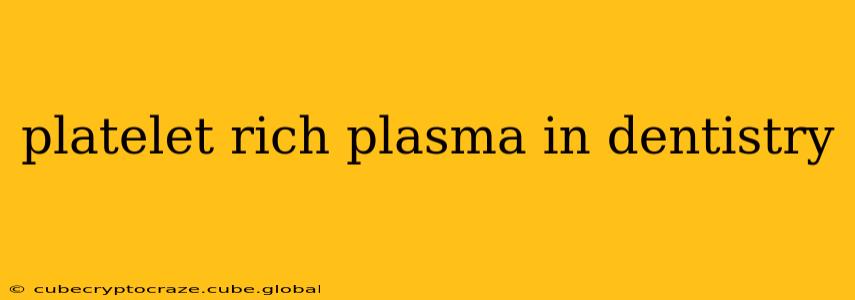Platelet-Rich Plasma (PRP) therapy is revolutionizing various medical fields, and dentistry is no exception. This innovative treatment harnesses the body's natural healing capabilities to promote faster and more effective tissue regeneration. This comprehensive guide explores the applications, benefits, and potential drawbacks of PRP in dentistry.
What is Platelet-Rich Plasma (PRP)?
PRP is a concentrated solution derived from a patient's own blood. The process involves drawing a blood sample, centrifuging it to separate the platelets (blood cells essential for clotting and tissue repair) from other blood components, and then activating the platelets to release growth factors. These growth factors stimulate cell proliferation, accelerate healing, and improve tissue regeneration. This autologous (self-derived) nature minimizes the risk of allergic reactions or disease transmission.
How is PRP Used in Dentistry?
PRP finds diverse applications in various dental procedures, significantly enhancing outcomes.
1. Socket Preservation:
After tooth extraction, the resulting socket can experience bone loss, making future implant placement challenging. PRP, when applied to the extraction site, stimulates bone regeneration, preserving the socket's volume and facilitating easier implant integration later.
2. Guided Bone Regeneration (GBR):
In cases of significant bone loss, GBR techniques utilize bone grafts and membranes to regenerate bone tissue. Incorporating PRP into GBR procedures significantly enhances bone formation, leading to improved implant stability and aesthetics.
3. Sinus Augmentation:
Sinus augmentation, a procedure to increase the bone volume in the maxillary sinus (upper jaw), often involves bone grafting. The addition of PRP accelerates bone growth, improving the procedure's success rate and reducing healing time.
4. Periodontal Regeneration:
Periodontal disease, characterized by gum inflammation and bone loss, can lead to tooth loss. PRP therapy, when used in conjunction with other periodontal treatments, promotes tissue regeneration, reducing pocket depths and improving overall periodontal health.
5. Soft Tissue Grafting:
Soft tissue grafting, used to treat gum recession or cover exposed tooth roots, benefits from PRP's regenerative properties. PRP enhances tissue healing, resulting in improved aesthetic outcomes and reduced post-operative discomfort.
6. Improving Healing After Dental Implants:
PRP can be used to accelerate the osseointegration (bone growth around the implant) process, leading to quicker functional recovery and increased implant longevity.
What are the Benefits of PRP in Dentistry?
The advantages of incorporating PRP into dental procedures are substantial:
- Faster Healing: PRP significantly accelerates the healing process, reducing recovery time and discomfort.
- Improved Tissue Regeneration: The growth factors in PRP stimulate the regeneration of bone, gum tissue, and other oral structures.
- Enhanced Aesthetic Outcomes: PRP contributes to improved aesthetic results in procedures like soft tissue grafting and bone augmentation.
- Increased Implant Success Rates: PRP improves implant osseointegration, leading to higher success rates and longevity.
- Reduced Post-Operative Pain and Swelling: The accelerated healing process often translates to less post-operative pain and inflammation.
- Minimally Invasive Procedure: PRP is derived from the patient's own blood, minimizing the risk of allergic reactions or disease transmission.
What are the Potential Risks and Side Effects of PRP in Dentistry?
While generally safe, PRP therapy can have some potential drawbacks:
- Mild Pain or Swelling: Some patients experience mild discomfort or swelling at the injection site.
- Bruising: Minor bruising is possible at the blood draw site or PRP injection site.
- Infection: As with any procedure involving a needle puncture, there's a small risk of infection. Strict sterile techniques minimize this risk.
- Cost: PRP therapy can be more expensive than traditional dental procedures.
What are the Alternatives to PRP in Dentistry?
Alternatives to PRP in dentistry include traditional bone grafting materials (like autografts, allografts, or xenografts), guided tissue regeneration membranes, and other regenerative therapies. The choice of treatment depends on the specific clinical situation and the patient's individual needs.
Is PRP in Dentistry Covered by Insurance?
Insurance coverage for PRP therapy varies widely depending on the insurance provider and the specific procedure. It's essential to contact your insurance company to determine your coverage before undergoing treatment.
How Much Does PRP Treatment in Dentistry Cost?
The cost of PRP therapy in dentistry depends on various factors, including the specific procedure, the amount of PRP required, and the dentist's fees. It's best to consult with your dentist for a personalized cost estimate.
How Long Does it Take to See Results From PRP in Dentistry?
The time it takes to see results from PRP therapy varies depending on the procedure. In some cases, improvement may be visible within weeks, while other procedures may require several months to achieve optimal results. Your dentist will provide you with a realistic timeline based on your specific treatment.
This information is for general knowledge and should not be considered medical advice. Always consult with a qualified dental professional to discuss your specific dental needs and the suitability of PRP therapy for your condition.
